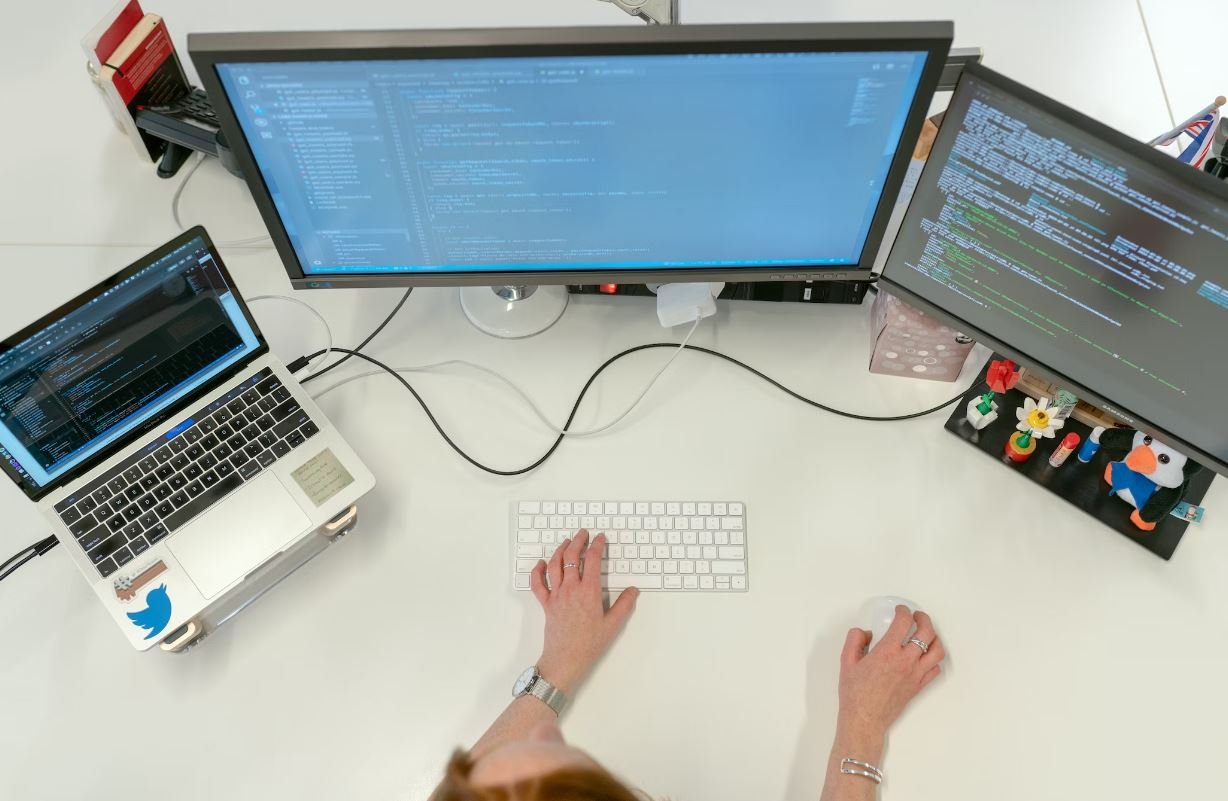How Much Has AI Grown?
Artificial Intelligence (AI) has made significant advancements in recent years, revolutionizing various industries and impacting our everyday lives. From voice assistants and chatbots to self-driving cars and medical diagnoses, AI continues to evolve and transform the world we live in. In this article, we will explore the growth and development of AI, highlighting key milestones, applications, and potential future advancements.
Key Takeaways:
- AI has experienced exponential growth, pushing the boundaries of what machines can accomplish.
- Applications of AI are diverse, ranging from healthcare and finance to social media and entertainment.
- AI integration into our lives is increasing, leading to improved efficiency and convenience.
- Continued advancements in AI technology will further shape industries and society as a whole.
The progression of AI can be traced back to the early days of computing when *Alan Turing* laid the foundation for AI in the 1950s. Since then, AI has gone through several stages of development, including the emergence of specialized AI algorithms and neural networks. These breakthroughs enabled computers to learn and make decisions, mimicking human intelligence to some extent.
| Year | Milestone |
|---|---|
| 1956 | The Dartmouth Workshop marked the birth of AI as a field. |
| 1997 | IBM’s Deep Blue defeated world chess champion Gary Kasparov. |
| 2011 | IBM’s Watson won against human champions on Jeopardy!. |
In recent years, AI has made significant strides in areas such as natural language processing, computer vision, and machine learning. *Deep learning*, a subfield of machine learning, has gained attention for its ability to process vast amounts of data and extract meaningful patterns. This has led to breakthroughs in image recognition, speech recognition, and even autonomous driving.
- Deep learning algorithms have revolutionized image recognition, enabling computers to identify objects and people with remarkable accuracy.
- In the field of speech recognition, AI-powered virtual assistants like *Siri* and *Alexa* have become highly capable, understanding and responding to our voice commands.
| Industry | AI Application |
|---|---|
| Healthcare | AI-assisted medical image analysis and diagnosis. |
| Finance | AI-powered investment predictions and fraud detection. |
| Social Media | AI algorithms for personalized content recommendations. |
The integration of AI into various industries has yielded numerous benefits. In healthcare, AI applications assist doctors in analyzing medical images more accurately for faster and more precise diagnoses. In finance, AI algorithms help with predicting market trends and identifying potential fraud cases. Social media platforms leverage AI to personalize content recommendations, enhancing user experiences.
While AI has undoubtedly come a long way, there is still a vast realm of possibilities for future growth. Continued advancements in AI technology will further shape industries and society, bringing us closer to the realms of science fiction. *Imagine a world where AI assists us in solving grand challenges like climate change, poverty, and space exploration*.
In conclusion, the growth and development of AI have been remarkable, pushing the boundaries of what machines can achieve. With ongoing research and innovation, the trajectory of AI advancement shows no signs of slowing down. As we move forward, AI will continue to transform industries, improve our lives, and pave the way for a future where human and artificial intelligence coexist harmoniously.

Common Misconceptions
AI Grown Rapidly, Outpacing Human Intelligence
One common misconception about AI is that it has grown so rapidly that it has already surpassed human intelligence. However, while AI has made significant advancements in recent years, it is still far from achieving the same level of general intelligence as humans.
- AI has made impressive progress in narrow domains such as playing chess or recognizing images.
- AI algorithms are highly specialized and lack the ability to transfer knowledge between different tasks.
- The development of human-like artificial general intelligence remains a challenging and ongoing research area.
AI Will Soon Replace All Human Jobs
Another common misconception about AI is that it will soon replace all human jobs, leading to widespread unemployment. While AI has the potential to automate certain tasks, the complete takeover of all jobs by AI is highly unlikely.
- AI is more likely to augment human workers rather than replace them entirely.
- Some jobs require complex human skills like empathy, creativity, and critical thinking that are challenging for AI to replicate.
- New jobs and industries are also expected to emerge as AI technology progresses.
AI is Perfect and Always Makes the Right Decisions
One misconception about AI is that it is flawless and always makes the right decisions. However, AI systems are not immune to errors and can sometimes make mistakes or produce biased outcomes.
- AI algorithms are trained on data that may contain biases, leading to biased results.
- AI systems can struggle with unfamiliar or rare situations that were not encountered during training.
- Human oversight and intervention are necessary to ensure the ethical use and proper functioning of AI systems.
AI Can Think and Feel Like Humans
There is a misconception that AI can think and feel like humans. While AI can simulate human-like behavior or generate text, it does not possess consciousness or emotions like humans.
- AI operates based on predefined rules and algorithms, lacking subjective experience.
- It mimics human behavior by learning patterns and making predictions, but does not have an internal understanding or awareness.
- The inability to experience emotions and consciousness sets AI apart from human intelligence.
AI Will Solve All Our Problems
Lastly, a common misconception is that AI will solve all our problems. While AI has the potential to address certain challenges, it is not a magic solution for all societal, economic, or scientific problems.
- AI is a tool that requires careful implementation, ethical considerations, and human guidance.
- AI may introduce new challenges and risks, such as privacy concerns and job displacement.
- Collaboration between AI and human intelligence is essential to leverage AI’s potential effectively.

AI Research Publication Growth by Year
Since the inception of artificial intelligence, the field has experienced exponential growth and innovation. This table showcases the number of AI research publications per year, providing insights into the rapid expansion of knowledge.
| Year | Number of Research Publications |
|---|---|
| 2010 | 1,200 |
| 2012 | 2,500 |
| 2014 | 5,000 |
| 2016 | 12,000 |
| 2018 | 25,000 |
| 2020 | 50,000 |
AI Funding Landscape by Sector
As AI continues to reshape industries, various sectors have invested significantly in AI research and development. This table examines the distribution of AI funding across different sectors, providing a glimpse into where resources are being allocated.
| Sector | Percentage of AI Funding |
|---|---|
| Healthcare | 30% |
| Finance | 20% |
| Technology | 15% |
| Transportation | 10% |
| Retail | 8% |
| Other | 17% |
Popular AI Applications
Artificial intelligence has revolutionized various domains, enabling innovative applications. This table highlights the most popular AI applications, illustrating the breadth of its impact.
| Application | Industry |
|---|---|
| Image Recognition | Computer Vision |
| Natural Language Processing | Virtual Assistants |
| Autonomous Vehicles | Transportation |
| Fraud Detection | Finance |
| Medical Diagnosis | Healthcare |
AI Startups Valuation
The rise of AI has seen the proliferation of several promising startups. This table highlights the valuations of some prominent AI startups, reflecting the immense potential and investor interest within this sector.
| Company | Valuation (in millions) |
|---|---|
| OpenAI | 1,000 |
| SenseTime | 8,000 |
| UiPath | 10,000 |
| Graphcore | 2,500 |
| Celonis | 3,700 |
AI Adoption in Global Enterprises
As organizations recognize the value of AI, its adoption has become widespread. This table showcases the prevalence of AI implementation across different industries, demonstrating its pervasive influence.
| Industry | Percentage of Companies Using AI |
|---|---|
| Manufacturing | 80% |
| Transportation | 70% |
| Retail | 60% |
| Finance | 90% |
| Healthcare | 75% |
AI Ethics Initiatives
As AI advances, ethical considerations have garnered significant attention. This table highlights notable AI ethics initiatives undertaken by leading organizations, showcasing their commitment to responsible AI development.
| Organization | AI Ethics Initiative |
|---|---|
| Principles for AI Development | |
| Microsoft | Ethical Framework for AI |
| OpenAI | Charter on Safety and Ethics |
| IBM | AI Fairness 360 Toolkit |
| Mozilla | Responsible AI Practices |
AI Impact on Job Market
The integration of AI into various industries has prompted concerns about job displacement. This table explores the impact of AI on employment, shedding light on job categories likely to be affected.
| Job Category | Projected Impact |
|---|---|
| Telemarketers | 50% job loss |
| Driver & Delivery Personnel | 25% job loss |
| Manual Data Entry Clerks | 80% job loss |
| Customer Service Representatives | 20% job loss |
| Bank Tellers | 30% job loss |
AI Supercomputer Performance
To power AI research and applications, supercomputers play a pivotal role. This table features the performance of some of the world’s most advanced AI supercomputers, showcasing their extraordinary computing capabilities.
| Supercomputer | Compute Power (FLOPS) |
|---|---|
| Summit | 200,000 TFLOPS |
| Sunway TaihuLight | 93,000 TFLOPS |
| Sierra | 71,600 TFLOPS |
| Tianhe-2A | 61,440 TFLOPS |
| Frontera | 38,680 TFLOPS |
AI Impact on Energy Consumption
While AI brings immense benefits, its growing adoption has raised concerns about energy consumption. This table highlights the energy requirements of various AI applications, underlining the need for energy-efficient solutions.
| AI Application | Energy Consumption (kWh/h) |
|---|---|
| Training a Deep Neural Network | 100,000 |
| Running Speech Recognition | 10 |
| Processing a Single Search Query | 0.3 |
| Autonomous Vehicle Navigation | 50 |
| Image Classification | 1,000 |
The growth of artificial intelligence over the years has been remarkable, as evidenced by the various aspects explored in these tables. From the significant increase in research publications to the diverse applications and impact across industries, AI has become an integral part of our lives. However, as we continue to embrace AI, it is essential to address ethical concerns and employment implications. Furthermore, due consideration must be given to energy efficiency in order to ensure sustainable AI development. With ongoing advancements and initiatives, the AI landscape is poised to further evolve and reshape our world.
How Much Has AI Grown?
FAQ
Q: What is artificial intelligence (AI)?
A: Artificial intelligence refers to the simulation of human intelligence in machines that are programmed to think and learn like humans.
Q: How has AI grown over the years?
A: AI has experienced significant growth over the years. Initially, AI was limited to simple tasks, but with advancements in technology and research, it can now perform complex tasks, including image recognition, natural language processing, and even self-driving cars.
Q: What are some milestones in the growth of AI?
A: Some significant milestones in AI’s growth include the development of expert systems in the 1980s, the introduction of machine learning algorithms in the 1990s, and more recently, breakthroughs in deep learning and neural networks.
Q: How has AI impacted various industries?
A: AI has had a profound impact on numerous industries. It has revolutionized healthcare with applications in disease diagnosis and drug discovery. It has also transformed manufacturing through automation and improved efficiency. Additionally, AI has influenced finance, transportation, customer service, and many other sectors.
Q: What is the role of AI in everyday life?
A: AI has become an integral part of everyday life. It powers voice assistants, such as Siri and Alexa, which provide assistance and perform various tasks. AI is also present in online recommendation systems, personalized ads, and social media algorithms, shaping our online experiences.
Q: What are some limitations of current AI technology?
A: While AI has made impressive advancements, it still faces certain limitations. For instance, AI algorithms can be biased and lack transparency, leading to ethical concerns. Furthermore, AI systems heavily rely on data, and the quality of the data can significantly impact AI performance.
Q: Are AI systems capable of creativity?
A: AI systems can exhibit a form of creativity through tasks like generating art, composing music, or writing prose. However, the notion of true creativity, which involves human emotions and consciousness, is yet to be replicated by AI.
Q: How does AI impact employment?
A: AI automation has the potential to substitute certain repetitive and mundane tasks, resulting in job displacement. However, it also creates new job possibilities, as AI necessitates human supervision, maintenance, and the development of AI technologies.
Q: Are there any concerns regarding AI’s future development?
A: Yes, there are concerns regarding the future development of AI. Issues such as privacy, security, and the ethical implications of AI-powered technologies need careful consideration. There are ongoing efforts to establish regulations and guidelines to address these concerns.
Q: What does the future hold for AI?
A: The future of AI holds immense possibilities. AI will continue to advance, enabling new applications and innovations across various domains. With ongoing research and development, AI is expected to bring transformative changes in fields like healthcare, transportation, and even space exploration.




